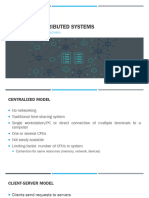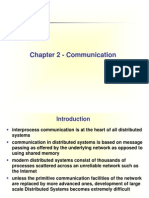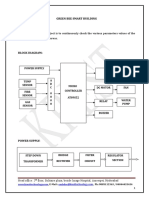0% found this document useful (0 votes)
164 views17 pagesCase Study: Distributed OS
The Amoeba distributed operating system used a microkernel architecture with client-server model. Servers managed shared objects like files, directories, memory segments. Communication between clients and servers used remote procedure calls. It had modular servers like Bullet (read-only file server) and Soap (maps file names to capabilities). Processes, memory and communication were also implemented as protected objects. The system provided location independence, fault tolerance and high availability through replication and capabilities for access control.
Uploaded by
Katama Raju BandigariCopyright
© Attribution Non-Commercial (BY-NC)
We take content rights seriously. If you suspect this is your content, claim it here.
Available Formats
Download as PPT, PDF, TXT or read online on Scribd
0% found this document useful (0 votes)
164 views17 pagesCase Study: Distributed OS
The Amoeba distributed operating system used a microkernel architecture with client-server model. Servers managed shared objects like files, directories, memory segments. Communication between clients and servers used remote procedure calls. It had modular servers like Bullet (read-only file server) and Soap (maps file names to capabilities). Processes, memory and communication were also implemented as protected objects. The system provided location independence, fault tolerance and high availability through replication and capabilities for access control.
Uploaded by
Katama Raju BandigariCopyright
© Attribution Non-Commercial (BY-NC)
We take content rights seriously. If you suspect this is your content, claim it here.
Available Formats
Download as PPT, PDF, TXT or read online on Scribd
/ 17

























































































